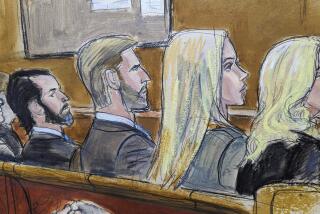U.S. judge in obscenity trial steps down
A federal appeals court judge on Friday stepped down from a high-profile obscenity trial in Los Angeles, three days after acknowledging that he had posted sexually explicit material on a publicly accessible personal website.
“In light of the public controversy surrounding my involvement in this case, I have concluded that there is a manifest necessity to declare a mistrial,” wrote Alex Kozinski, chief judge for the U.S. 9th Circuit Court of Appeals. “I will recuse myself from further participation in the case and will ask the chief judge of the district court to reassign it to another judge.”
On Wednesday, Kozinski suspended the trial of Hollywood filmmaker Ira Isaacs to allow the prosecutor to explore what he saw as “a potential conflict of interest concerning the court having a . . . sexually explicit website with similar material to what is on trial here.”
Prosecutor Kenneth Whitted, who had expressed dismay with one of Kozinski’s earlier rulings in the case, declined to comment on the judge’s recusal.
Isaacs, the defendant, said he was disappointed Kozinski was no longer the judge.
“I thought he was a fair judge,” he said. “I feel terrible that my trial caused this information to come out.”
He added, though, that it was somehow fitting for the trial, which he predicted would be a spectacle from the start. Isaacs planned to argue that his hard-core videos depicting acts of bestiality and defecation were works of art and therefore not legally obscene. Jurors spent several hours Wednesday watching the videos before the trial was interrupted.
“This whole trial is one big piece of performance art,” Isaacs said. “I just can’t imagine what’s going to happen next.”
The halting of Isaacs’ trial came after The Times published an article on its website describing some of the sexually themed content on the judge’s website. In an interview Tuesday, Kozinski had acknowledged posting the images but said he believed it was a private storage area that could not be accessed by the public. Had he known it was not properly protected, he said, he would have been more careful about the content he kept there. He acknowledged that some of the material was inappropriate but defended other items as funny. He said he must have uploaded some of the material by accident.
Following the interview, he blocked access to the site. After the story broke, the judge issued a statement saying his adult son told him that he may have placed some of the controversial material on the website.
In addition to declaring a mistrial, Kozinski -- a nationally respected judge who has been mentioned as a potential Supreme Court candidate -- also called for an investigation of himself. He issued a statement Thursday asking the Judicial Council of the 9th Circuit to “initiate proceedings” in response to The Times article.
Laurie Levenson, a Loyola Law School professor and former federal prosecutor in Los Angeles, said Kozinski has taken the right steps to put the issue behind him.
“The best thing for him to have done was to extricate himself as much as possible, and I think that’s what he’s done,” she said.
Before it was taken down Tuesday, visitors to https://alex.kozinski.com were greeted with the message: “Ain’t nothin’ here. Y’all best be movin’ on, compadre.” But adding “/stuff” to the address revealed a hodgepodge of material, including music files, essays, cartoons and family photos.
Kozinski himself occasionally linked the public to his site. For example, in a letter published on the New York Times website in November 2005, he directed readers to his site so they could see an old clip of him on “The Dating Game” show.
More recently, the files containing the sexual content were found by Cyrus Sanai, an attorney from Beverly Hills, who then alerted The Times. Sanai said he was conducting research in connection with a dispute he was having with Kozinski when a Google search led him to a directory on the judge’s website containing the material.
Many of the items on the website, some of which the judge said he received and sent via e-mail, are intended to be crudely humorous.
One such item is a photo of two women seated in what appears to be a cafe with their skirts hiked up to reveal their pubic hair. Behind them is a sign reading “Bush for President.” Kozinski defended that photo as “a funny joke.”
Among other items were a photo of two nude women painted to look like cows, a video of an encounter between a half-dressed man and a sexually aroused farm animal, a striptease slide show featuring a transsexual, a series of photos of women’s crotches in snug-fitting clothing or underwear and a step-by-step pictorial of a woman shaving her pubic hair.
Some nonsexual material on the website might also be considered demeaning to women: There was a mock mathematical equation presented as “proof that girls are evil,” and a photo of a 1950s-era mother and her daughter sharing a book titled, “Becoming a Bitch.”
Legal experts who had called on Kozinski to recuse himself from the Isaacs case said it wasn’t necessarily a problem that the judge had collected sexually explicit material but that he was reckless in allowing it to be discovered.
“The real problem is that once this came to light, it made people question whether he was the right judge to handle the case,” Levenson said. “And that’s a question that would never have arisen if he had not been so reckless in how he handled these materials.”
--
More to Read
Sign up for Essential California
The most important California stories and recommendations in your inbox every morning.
You may occasionally receive promotional content from the Los Angeles Times.











